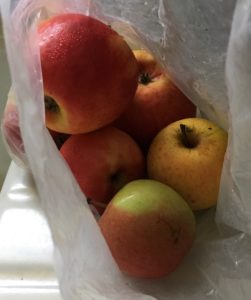Brrr! It’s cold here in Daytona Beach. At least, cold for us Floridians. Today’s high hit only the mid-50s and it’ll be going down to the 30s tonight. I know, for a lot of you who are dealing with real winter conditions, that doesn’t even qualify as chilly! But I’m most comfortable at temperatures around 85 degrees, and once the mercury dips below 65 I start reaching for the down vest and gloves!
This will be my 10th or 11th winter without using any artificial heating at home. It’s a choice motivated somewhat by money savings but even more by eco-footprint reduction. I say my main motivation is eco-footprint, but I sure do like my $15 electric bill! Many folks I know are paying $100, $200, or more. Heating and cooling are the biggest users of energy in most homes. It’s a lot easier and cheaper for people to personally heat and cool their own bodies, than it is to try to heat or cool the air in a dwelling to some agreed-upon level.
Since I live in a mild climate, going without heat is not that bad.
(Going without air conditioning is a non-issue for me, as I genuinely dislike forced-air cooling. I didn’t move to Florida to be cold ever, let alone cold in summer! I also dislike closed windows, but when it’s cool, I don’t mind them as much! My house windows are shut at the moment. The temperature outside is about 55; in here it is probably 65.)
To keep comfortable, I dress in layers. That’s the standard advice, and it works great. But also, I make use of microclimate. Have you ever noticed which rooms of your house tend to be cooler and which tend to be warmer? Also have you noticed the sun angle at different times of year?
In the warm months, my roofed patio is a cool shady heaven. When the weather turns cold, it loses its heavenly aspect and I don’t sit out there much! The living room is the warm room in winter: The sun angle at this time of year is low enough so that the sunlight comes under the awnings and strikes the tall windows, making this a pleasant room for typing and reading. It’s also a cozy space for gatherings.
My little studio-office-bedroom on the west side of the house is warm in the late afternoons with the dipping sun. Bathed in a gorgeous warm light that’s made warmer by my use of a sheer floral magenta curtain, it’s a nice place to work later in the day.
Light conditions vary too. The living room is getting darkish right now (it’s 4:39 pm EST), while my little studio office is bathed in that nice warm rosy light.
There are also dry and humid spots, both indoors and out. My concrete-surfaced patio, where lots of breezes pass through, is a dry microclimate and a great spot for my clothesline. In other places I’ve lived, where the clothesline was over grass and/or located in a spot that didn’t get as many breezes, clothes took longer to dry.
Bathrooms and kitchens tend to be humid microclimates. Sometimes too humid, especially a bathroom without a window (something I wouldn’t wish on anyone).
The real experts on microclimate are pets. If you’re not sure where the most comfortable places in your dwelling are at a given time of year — the warm spot in winter and the cool spot in summer — watch where your dog or cat hangs out.
In permaculture design class we were taught that microclimate is a huge factor, which can often override the prevailing climate. In my observation, that is true!
Courtyards on the north side of buildings, particularly tall office buildings, are rarely used. People gravitate to the sunny south sides of buildings. I’ve heard this is true even in summer.
Greenhouses create a warm moist microclimate. I’ve even heard of people growing lemons in the north of Scotland!
What examples of microclimate have you noticed in your home, office, or other environment you frequent?

